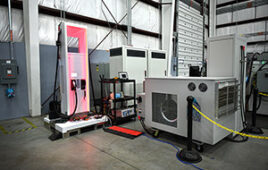Cornell physicists and engineers are lending their expertise in next-generation nanoscale electronics research as part of a new $35 million National Science Foundation (NSF) research center.
Cornell’s Craig Fennie, assistant professor of applied and engineering physics; Ephrahim Garcia, professor of mechanical and aerospace engineering; and Darrell Schlom, the Herbert Fisk Johnson Professor of Industrial Chemistry and professor of materials science and engineering, will join researchers from several institutions in creating highly efficient, powerful electromagnetic systems no bigger than biological cells.
The NSF recently announced the creation of the new Engineering Research Center, to be housed at the University of California — Los Angeles (UCLA), which will draw on expertise from Cornell, the University of California — Berkeley, Switzerland ETH Zurich and California State University — Northridge.
The Cornell researchers represent a microcosm of the entire project, said Cornell lead researcher Garcia: Fennie does analytic first-principles modeling of new materials, Schlom works on fabrication processes of materials, and Garcia focuses on new applications for novel materials.
The center, called Translational Applications of Nanoscale Multiferroic Systems, will aim to replace traditional, wire-based electronics with a new technique to couple electricity and magnetism using “smart” materials called multiferroics, which can be magnetically switched on and off by an electric field, according to UCLA’s press release about the new center.
The systems, according to UCLA, will eventually power a range of devices, from miniaturized consumer electronics and technologies important for national security to as-yet-unimagined machines, like nanoscale motors and other actuators for a variety of applications.
The Cornell team is looking at exploiting the properties of piezoelectric and magnetostrictive materials. A piezoelectric ceramic material creates electric fields generated by stress on the material, while a magnetostrictive material creates magnetic fields coupled to that stress. These types of compounds could form the basis for new, wire-free electronics by creating magnetics fields without the need for coils.
Cornell will also be involved in the center’s education and outreach component, involving increased opportunities for minority and women students to consider careers in engineering, Garcia said. Students in the program will be encouraged to think outside the confines of traditional disciplines.
“Engineering isn’t simply about math and science, but potentially it can be a conduit for enterprise, and we want students to think about that,” Garcia said.




